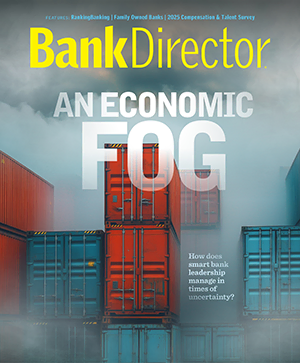Budget constraints have long been a challenge for financial institutions. Spending is always under pressure, and leaders are constantly being asked to do more with less. Today, that pressure feels even more intense. I’m hearing the same thing across nearly every conversation: Budgets are tight, and teams are being asked to squeeze more performance out of what they already have.
We know that economic uncertainty and rising costs are forcing banks to scrutinize every tech investment. Institutions are reassessing how they can achieve their growth strategies with fewer resources. Innovation teams are also being asked to demonstrate the return on investment (ROI) before bringing on new tools.
While there’s a lot of talk about cutting tools, there’s not enough conversation about looking under the hood. Policy is often the one area that hasn’t been re-evaluated in years, and it’s where institutions can make some of their biggest gains.
The Hidden Value of Policy Optimization
For whatever reason, most institutions overlook the potential gains from fine-tuning their existing credit and risk policies. In fact, when I work with clients, I always ask if their policies align with today’s borrower behavior. Nine times out of 10, the answer is, “Probably not.”
Small changes in policy logic can yield significant improvements in efficiency and outcomes. And these policy updates are often more cost-effective than deploying new solutions or platforms.
Ask yourself if your policies are:
- Outdated?
- Inconsistent across channels?
- Misaligned with current market conditions?
Perhaps your decisioning logic is based on historical data that no longer reflects borrower behavior. Or maybe you aren’t analyzing exception handling, overrides and manual reviews, leaving value on the table.
Real-Time Data as a Strategic Lever — Not a Cost
No one wants to take on a major system overhaul right now, and honestly, you don’t have to. Some of the most impactful changes come from smart policy tweaks, not expensive tech rollouts.
You don’t need new vendors to extract value from existing decisioning frameworks. Right now, it’s less about how many tools you have and more about how well you’re using the ones already in your stack. That’s where policy becomes the differentiator. You can use performance feedback and outcome data to refine their policies — all too often an underutilized strategy.
But the real innovation comes from embedding analytics into policy governance. By simulating policy changes using internal data, you can test your risk tolerances before going live with any policy changes. Promoting greater collaboration among risk, product, and analytics teams is important because it enables nimbler, data-backed policy adjustments.
Admittedly, this is a cultural shift from viewing policy management as a compliance checkbox to a strategic function. However, the amount of lift you can get from rethinking the rules you already have can be significant. It’s not about throwing out the playbook — it’s about rewriting a few key pages.
How to Maximize ROI From Policy Without Increasing Spend
Unsure how to apply this approach to your organization? Begin by:
1. Auditing existing policies for redundancy, outdated logic and misalignment with business goals.
2. Analyzing exception patterns and manual reviews to identify policy friction points.
3. Using internal performance data to inform targeted changes and forecast impact.
4. Creating cross-functional teams to simulate and test new policy rules in controlled environments.
5. Establishing feedback loops that continuously improve policies using real-time insights.
Smarter Beats Bigger
You don’t always need a bigger budget to make a bigger impact. Sometimes, the real progress comes from asking better questions and making more thoughtful adjustments.
Treating policy as a strategic tool rather than a set-it-and-forget-it checklist opens the door to better decisions, stronger results and more agility across the board. It’s not about overhauling everything. It’s about making what you already have work harder for you.




